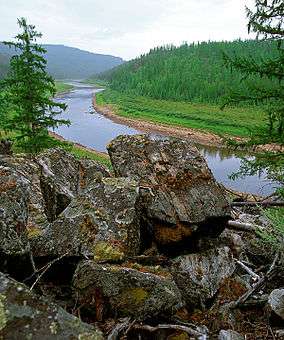Olyokma Nature Reserve
| Olyokma Nature Reserve | |
|---|---|
|
Russian: Олёкминский заповедник (Also: Olekminsky) | |
|
IUCN category Ia (strict nature reserve) | |
|
Olyokma Zapovednik | |
 Location of Reserve | |
| Location | Sakha Republic |
| Nearest city | Olyokminsk |
| Coordinates | 58°39′22″N 122°15′28″E / 58.65611°N 122.25778°ECoordinates: 58°39′22″N 122°15′28″E / 58.65611°N 122.25778°E |
| Area | 847,102 hectares (2,093,230 acres) |
| Established | 1984 |
| Governing body | Ministry of Natural Resources and Environment (Russia) |
| Website | http://olekminskiy.ru/ |
Olyokma Nature Reserve (Russian: Олёкминский) (also Olekminsky) is a Russian 'zapovednik' (strict nature reserve) located south of the middle reaches of the Lena River on the right bank of its second largest tributary - the Olyokma River at the junction of the Aldan plateau and Prilenskoye plateau in Olyokminsky District of the Sakha Republic (Yakutia). The area is remote and relatively undisturbed, being 80 km from a town.[1][2]
Topography
The region is in the foothills of southwest Yakutia, on the Prilenskoye-Aldan plateau, an area cut by river valleys. The major rivers of the Prilenskoye plateau are the Tuolby and Amga River. Within the borders of the reserve are 85 streams and rivers stretching from 3 to 110 km, acting as tributaries of the Olyokma, Tuolby, and Amga.[1]
Climate and Ecoregion
Olyokma is located in the East Siberian taiga ecoregion. The ecoregion covers the area between the Yenisei River and Lena River down to the Okhotsk Sea. Its northern border reaches the Arctic Circle, and its southern border reaches 52°N latitude. The dominant vegetation formation is light coniferous taiga with Dahurian larch Larix gmelini forming the canopy in areas with low snow cover. This ecoregion is rich in minerals.[3]
The climate of Olyokma is Humid continental climate, cool summer (Köppen climate classification (Dfc)). This climate is characterised by long cold winters, and short, cool summers.[4] Snow begins in October in Olekminsky, and last on average 200 days. Average annual precipitation is 400–500 mm.
Flora and Fauna
The reserve is covered 88% by forest, mostly conifers. Some zoning is seen: above 1,000 meters are more tundra communities, in a belt at 900–1000 meters is a sub-taiga of Dahurian larch, and from 400–900 meters is larch-pine forest with alder and rhododendron understory.[1] Olyokma is notable for relatively high levels of bidoversity: of the total 1,010 species of vascular plants in the East Siberian taiga ecoregion, 650 are found in Olyokma.[3]
Ecotourism
As a scientific nature reserve, the Olyokma Reserve is mostly closed to the general public, although scientists and those with 'environmental education' purposes can make arrangements with reserve management for visits. There are a few 'ecotourist' routes in the reserve that are made available to a limited number of school groups and ecotourists accompanied by reserve guides, and which require permits to be obtained in advance. The main office is in the city of Olekminsk.[1] [1]
See also
References
- 1 2 3 4 5 "Olyokma Zapovednik (Official Site)" (in Russian). Ministry of Natural Resources and Environment (Russia). Retrieved January 21, 2016.
- ↑ "Olyokma Zapovednik" (in Russian). Ministry of Natural Resources and Environment (Russia). Retrieved January 21, 2016.
- 1 2 "East siberian taiga'". World Wildlife Fund. Retrieved February 12, 2016.
- ↑ "Climate of Olyokma". GloalSpecies.org. Retrieved January 21, 2016.
External links
| Wikimedia Commons has media related to Olyokminsky Nature Reserve. |
